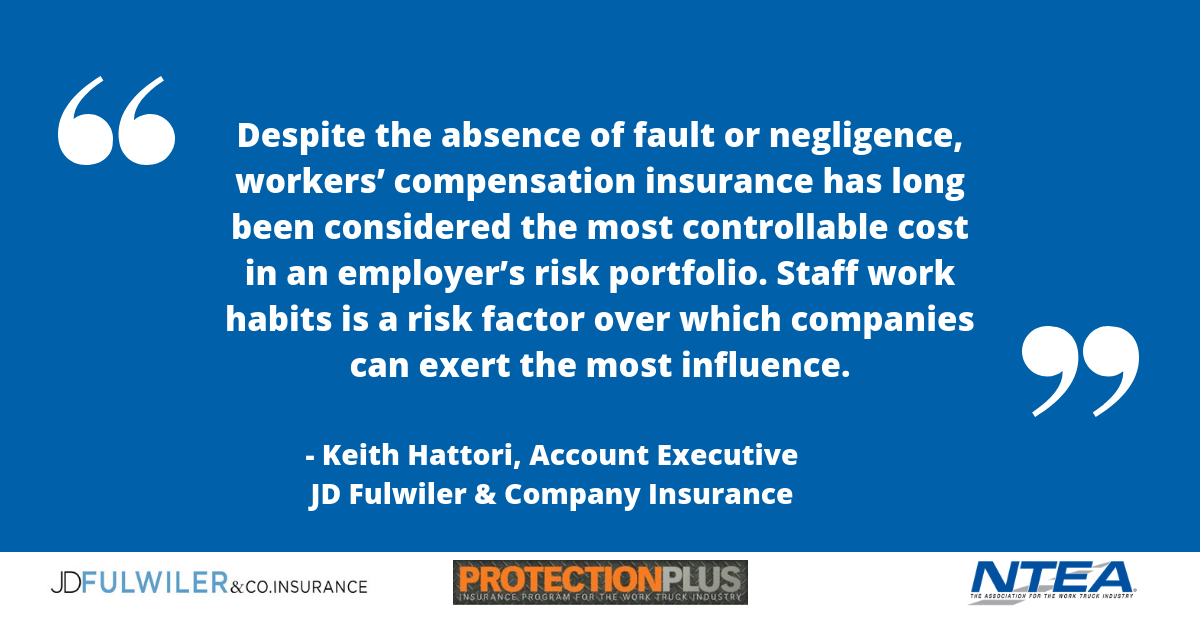
Guest editorial
By: Keith Hattori, Account Executive, JD Fulwiler & Company Insurance
This article was published in the January 2017 edition of NTEA News.
The basic concept of workers’ compensation is if employees are injured during the course of work, they will be taken care of regardless of fault. The other side of this agreement is that employees (in most states) cannot sue for on-the-job injuries no matter the party responsible. It’s the grand compromise of the insurance world.
Despite the absence of fault or negligence, workers’ compensation insurance has long been considered the most controllable cost in an employer’s risk portfolio. Staff work habits is a risk factor over which companies can exert the most influence. Recently, this idea has been magnified to a greater degree than before. Here’s why.
The National Council on Compensation Insurance (NCCI) governs workers’ comp regulation in 38 states. It serves many roles, including developing, determining, defining and calculating base rates for class codes. But the most employer-direct function provided by NCCI is the annual calculation of your experience modifier. As an employer with workers’ compensation insurance, you likely know the importance of your experience mod. Its most vital function is that it serves as a direct multiplier of your premium — meaning, if you have a 1.25 mod, you will pay a 25 percent surcharge above your annual premium. Conversely, if you earned a credit mod, your premium will be discounted accordingly.
What you may not know is that in 2013, NCCI made a change to the experience mod formula, altering what is called the split point in the equation. This is a balanced position between the two main components of loss history: frequency and severity. Without getting into the math, it essentially means larger losses are now more punitive to the employer than before 2013. Each year, the formula is adjusted slightly to maintain that weighting.
The good news is the reward for avoiding large losses is also greater. Think of all the experience mods for every employer in 38 states. Their mean-average has not moved, but to a large degree, they have been pushed away from the median 1.00 mod point, and they now represent a far wider range of numbers.
What does this mean for you, the employer? It depends on your loss history. If you have claims with incurred losses of more than $10,000, $15,000 or $16,500 (2016’s split-point), then you will notice they are driving your mod up more than they would have a few years ago. However, if you have a relatively clean loss history, your mod may be lower than ever.
What can you do?
This goes back to the old adage about workers’ comp being the most controllable cost factor in your risk portfolio. With a wider range of potential experience mods, it’s even more important for you as an employer to do everything possible to reduce likelihood of future claims and control costs of claims that do occur.
Emphasis on employee safety is always key to reducing the risk of future claims, but what does that really mean? Perhaps regularly sitting down with your workers’ comp agent and going through a full loss history analysis. Doing so can help you identify risk factors in the workplace where procedure adjustments can prevent potential injuries.
Claims mitigation is another way to limit your loss experience. It has always been good practice to encourage recovering employees to return to work. But now that the larger time-loss claims are counting so heavily against your experience mod, it is that much more important to have light-duty tasks available. Working with the injured employee, claims examiner and your agent to provide back-to-work options is a practical way to keep the injured worker engaged and motivated. But now, it is far more likely to limit the spike to your experience mod, thereby reducing your premium payments. And don’t forget every workers’ comp claim will affect your experience mod for not one, but three full years.
As NTEA’s preferred insurance agency, JD Fulwiler developed the Protection Plus program to provide the industry with underwriting, risk assessment and loss prevention services. JD Fulwiler will shop among many top insurance carriers with which it does business to find a coverage solution that best meets your needs.